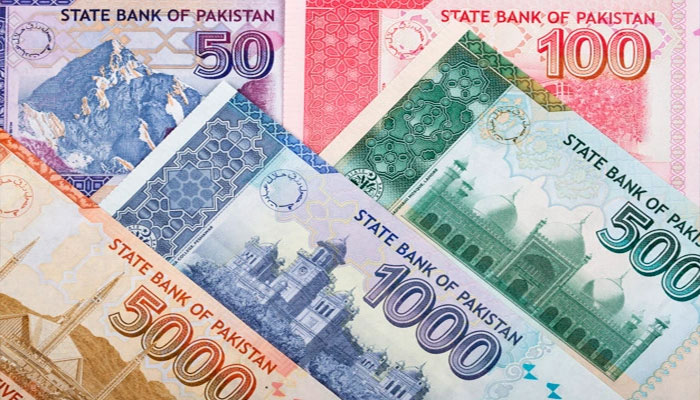Rupee seen stable on soft demand
KARACHI: Rupee is expected to trade stable against the dollar in the week ahead helped by strong remittance inflows ahead of the holy month of Ramazan and importers’ waning appetite for hard currency, traders said.
“Next week, I think because most importers are reluctant to get forward booking owing to the rising coronavirus cases in the country, there won’t be much demand in the market and we may see the rupee to hold steady or strengthen just a little bit,” said a currency trader at a commercial bank.
Increasing dollar inflows in the form of remittances from Pakistani workers employed abroad with the approach of fasting month of Ramazan (to be commenced from next week) will contribute, matching the demand of US currency in the market, if it surges,” the trader said.
“We expect the rupee to trade 152. 60 to 153.20 per dollar in the coming days,” said another trader.
The rupee gained 72 paisas or 0.46 percent against the dollar in the interbank market this week. The local unit closed at 153.66 to the dollar on Monday. However, persistent lower import payments and better inflows helped the rupee conclude the week at 152.94 per dollar.
The rupee was also supported by the boost in the foreign exchange reserves following the proceeds of Eurobonds issuance.
State Bank of Pakistan has received the proceeds of the government's $2.5 billion Eurobond issuance in its account. As a result, SBP’s foreign exchange reserves closed above $16 billion, their highest level since July 2017. The country’s reserves fell to $20.679 billion as of April 02, from $20.836 billion in the previous week.
The reserves held by the central bank decreased $146 million to $13.527 billion, due to external debt repayments.
The International Monetary Fund in its country report published this week said the SBP remains committed to a market-determined exchange rate and further accumulating reserves. This remains crucial to absorb external shocks, maintain competitiveness and current account sustainability, and build adequate reserve buffers.
“Going forward, the authorities will continue to (i) use purchases in the FX interbank market to rebuild reserve buffers amid favorable market conditions, but not to influence exchange rate trends; and (ii) limit sales to only offset disorderly market conditions,” it said.
Despite some easing of existing exchange restrictions and multiple currency practice (MCP), further extension of those remaining is needed.
Introduced at a time of heightened volatility to support the balance of payments (BOP), the authorities still maintain an exchange restriction and MCP arising from the imposition of a 100 percent cash margin requirement on imports of certain goods (imposed in 2017); and an exchange restriction resulting from the limitation on advance payments for imports against letters of credit (LCs) and advance payments up to the certain amount per invoice (without LCs) for the import of eligible items (imposed in 2018), it added.
“The authorities have made progress in easing them but request more time to remove them fully when BOP [Balance of Payments] conditions permit and within the program period,” said the report.
-
 Gaten Matarazzo On Unbreakable Bonds Of 'Stranger Things'
Gaten Matarazzo On Unbreakable Bonds Of 'Stranger Things' -
 Beyonce, Jay-Z's Daughter Blue Ivy Carter's Massive Fortune Taking Shape At 14?
Beyonce, Jay-Z's Daughter Blue Ivy Carter's Massive Fortune Taking Shape At 14? -
 Meghan Markle Fulfills Fan Wish As She Joins Viral 2106 Trend
Meghan Markle Fulfills Fan Wish As She Joins Viral 2106 Trend -
 Selena Gomez Proves Point With New Makeup-free Selfie On Social Media
Selena Gomez Proves Point With New Makeup-free Selfie On Social Media -
 John Mellencamp Shares Heartbreaking Side Effect Of Teddi's Cancer
John Mellencamp Shares Heartbreaking Side Effect Of Teddi's Cancer -
 Kate Middleton 'overjoyed' Over THIS News About Meghan Markle, Prince Harry
Kate Middleton 'overjoyed' Over THIS News About Meghan Markle, Prince Harry -
 'Harry Potter' Star Brendan Gleeson Reluctantly Addresses JK Rowling's Trans Views
'Harry Potter' Star Brendan Gleeson Reluctantly Addresses JK Rowling's Trans Views -
 Priscilla Presley Reveals The Path Elvis Would Have Taken If He Were Still Alive
Priscilla Presley Reveals The Path Elvis Would Have Taken If He Were Still Alive -
 Kianna Underwood's Death Marks Fourth Nickelodeon-related Loss In Weeks, 9th Since 2018
Kianna Underwood's Death Marks Fourth Nickelodeon-related Loss In Weeks, 9th Since 2018 -
 Hayden Christensen Makes Most Funny 'Star Wars' Confession Yet
Hayden Christensen Makes Most Funny 'Star Wars' Confession Yet -
 Subway Surfers City: Release Date, Exciting New Modes, And All The Big Changes Coming In 2026
Subway Surfers City: Release Date, Exciting New Modes, And All The Big Changes Coming In 2026 -
 Tom Ford's Brutal Behaviour With Ashton Kutcher Finally Exposed
Tom Ford's Brutal Behaviour With Ashton Kutcher Finally Exposed -
 Gaten Matarazzo Heaps Praise For Duffer Brothers
Gaten Matarazzo Heaps Praise For Duffer Brothers -
 Millions Of Bluetooth Earbuds At Risk Due To Google Fast Pair Flaw
Millions Of Bluetooth Earbuds At Risk Due To Google Fast Pair Flaw -
 Sarah Ferguson Believes 'royal Machine' Failed To Protect Her
Sarah Ferguson Believes 'royal Machine' Failed To Protect Her -
 'The Night Manager' Producer Proud To Guard Season Two Secret
'The Night Manager' Producer Proud To Guard Season Two Secret




